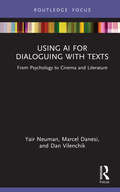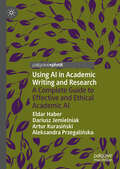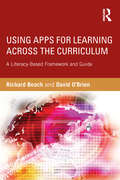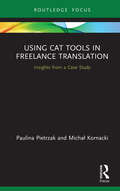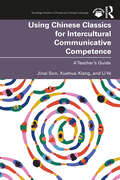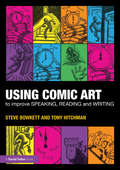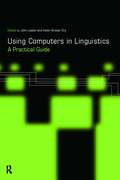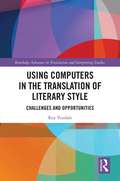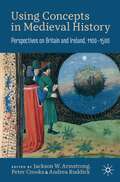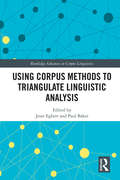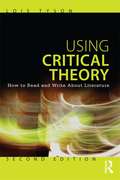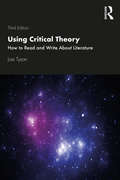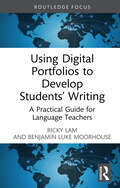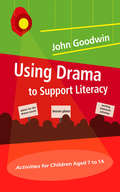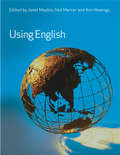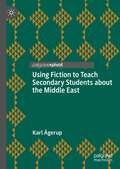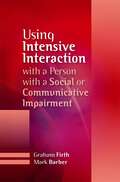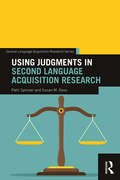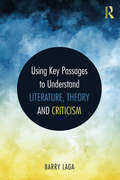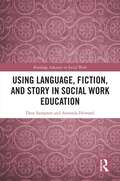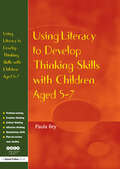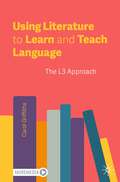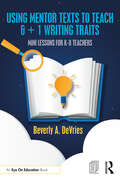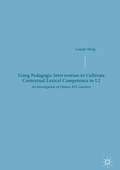- Table View
- List View
Using AI for Dialoguing with Texts: From Psychology to Cinema and Literature (Routledge Focus on Linguistics)
by Marcel Danesi Yair Neuman Dan VilenchikThis concise volume offers an accessible introduction to state-of-the-art artificial intelligence (AI) language models, providing a platform for their use in textual interpretation across the humanities and social sciences. The book outlines the affordances of new technologies for textual analysis, which has historically employed established approaches within the humanities. Neuman, Danesi, and Vilenchik argue that these different forms of analysis are indeed complementary, demonstrating the ways in which AI-based perspectives echo similar theoretical and methodological currents in traditional approaches while also offering new directions for research. The volume showcases examples from a wide range of texts, including novels, television shows, and films to illustrate the ways in which the latest AI technologies can be used for "dialoguing" with textual characters and examining textual meaning coherence. Illuminating the potential of AI language models to both enhance and extend research on the interpretation of texts, this book will appeal to scholars interested in cognitive approaches to the humanities, in such fields as literary studies, discourse analysis, media studies, film studies, psychology, and artificial intelligence.
Using AI in Academic Writing and Research: A Complete Guide to Effective and Ethical Academic AI
by Dariusz Jemielniak Eldar Haber Aleksandra Przegalińska Artur KurasińskiThis book comprehensively explores how AI tools can revolutionize academic writing, research, grant proposals, and educational practices. With a focus on practical applications, ethical considerations, and future trends, the book serves as an indispensable roadmap for academics, researchers, and educators eager to integrate AI into their work. Whether you're looking to enhance your research capabilities, craft compelling grant proposals, personalize learning experiences, or lead your institution into the future, this book provides the insights and tools necessary to navigate and shape the AI-enhanced landscape of academia. It demonstrates how to redefine scholarly work with cutting-edge AI innovations through real-life, practical examples, yet keeping the level of generalization high enough to keep it relevant for a few years. By balancing specific, actionable insights with broader perspectives, this book equips readers to not only adapt to but actively influence the evolving role of AI in higher education, research, and funding acquisition, ensuring its value as a resource both now and in the coming years.
Using Apps for Learning Across the Curriculum: A Literacy-Based Framework and Guide
by David O'Brien Richard BeachHow can apps be used to foster learning with literacy across the curriculum? This book offers both a theoretical framework for considering app affordances and practical ways to use apps to build students’ disciplinary literacies and to foster a wide range of literacy practices. Using Apps for Learning Across the Curriculum presents a wide range of different apps and also assesses their value features methods for and apps related to planning instruction and assessing student learning identifies favorite apps whose affordances are most likely to foster certain disciplinary literacies includes resources and apps for professional development provides examples of student learning in the classroom A website (www.usingipads.pbworks.com) with resources for teaching and further reading for each chapter, a link to a blog for continuing conversations about topics in the book (appsforlearningliteracies.com), and more enhance the usefulness of the book.
Using CAT Tools in Freelance Translation: Insights from a Case Study
by Paulina Pietrzak Michal KornackiThis book explores the impact of applying computer-assisted (CAT) tools in freelance translation toward better understanding translators’ strategies, preferences, and challenges in using new technologies and identifying areas of enhancement in translator training. The volume offers a brief overview of the latest developments in technology in translation, examining such issues as the effect on the translation process and the dynamics of the translator-technology interaction. Drawing on data from a study with active translators in Poland, Pietrzak and Kornacki examine the underlying factors underpinning translators’ lack of engagement with these tools, including such issues as prevailing pre-conceptions around technology and limited knowledge hindering the most efficacious use of these resources and the subsequent impact on translator identity. Taken together, the book brings together these insights to help pinpoint freelance translators’ needs more effectively and adapt training programmes accordingly. The volume will be of interest to scholars in translation studies with an interest in process and technology as well as active translators.
Using Chinese Classics for Intercultural Communicative Competence: A Teacher’s Guide (Routledge Studies in Chinese as a Foreign Language)
by Xuehua Xiang Jinai Sun Li YeUsing Chinese Classics for Intercultural Communicative Competence presents new strategies and tools for integrating Mandarin language teaching with fostering intercultural competencies through contemporary, global lenses on Chinese classic texts.Chinese classic texts are canonical works in Chinese culture published before 1911. They offer a window into deeply held cultural values which learners of the Chinese language would benefit from studying to facilitate meaningful intercultural dialogues. With chapters covering classic Chinese texts, such as Journey to the West, Dream of the Red Chamber, and The Romance of the Three Kingdoms, this book will demonstrate the value, importance, and feasibility of teaching Chinese classic works for ICC development in the Chinese world language classroom, and equip teachers with carefully planned, classroom-tested lesson models that demonstrate the innovative, integrative models advocated in this book.This book will be valuable for pre- and in-service Mandarin Chinese teachers across various institutional settings at different levels, looking for ready materials and professional development resources. The book can also be used as core material for teacher training programs.
Using Comic Art to Improve Speaking, Reading and Writing
by Steve BowkettUsing Comic Art to Improve Speaking, Reading and Writing uses children’s interest in pictures, comics and graphic novels as a way of developing their creative writing abilities, reading skills and oracy. The book’s underpinning strategy is the use of comic art images as a visual analogue to help children generate, organise and refine their ideas when writing and talking about text. In reading comic books children are engaging with highly complex and structured narrative forms. Whether they realise it or not, their emergent visual literacy promotes thinking skills and develops wider metacognitive abilities. Using Comic Art not only motivates children to read more widely, but also enables them to enjoy a richer imagined world when reading comics, text based stories and their own written work. The book sets out a range of practical techniques and activities which focus on various aspects of narrative, including: using comic art as a visual organiser for planning writing openings and endings identifying with the reader, using different genres and developing characters creating pace, drama, tension and anticipation includes ‘Kapow!’ techniques to kick start lessons an afterword on the learning value of comics. The activities in Using Comic Art start from this baseline of confident and competent comic-book readers, and show how skills they already possess can be transferred to a range of writing tasks. For instance, the way the panels on a comic’s page are arranged can serve as a template for organising paragraphs in a written story or a piece of non-fiction writing. The visual conventions of a graphic novel – the shape of speech bubbles or the way the reader’s attention is directed – can inform children in the use of written dialogue and the inclusion of vivid and relevant details. A creative and essential resource for every primary classroom, Using Comic Art is ideal for primary and secondary school teachers and TAs, as well as primary PGCE students and BEd, BA Primary Undergraduates.
Using Computers in Linguistics: A Practical Guide
by John M. Lawler Helen Aristar DryComputing has had a dramatic impact on the discipline of linguistics and is shaping the way we conceptualize both linguistics and language. Using Computers in Linguistics provides a non-technical introduction to recent developments in linguistic computing and offers specific guidance to the linguist or language professional who wishes to take advantage of them. Divided into eight chapters, each of the expert contributors focus on a different aspect of the interaction of computing and linguistics looking either at computational resources: the Internet, software for fieldwork and teaching linguistics, Unix utilities, or at computational developments: the availability of electronic texts, new methodologies in natural language processing, the development of the CELLAR computing environment for linguistic analysis.
Using Computers in the Translation of Literary Style: Challenges and Opportunities (Routledge Advances in Translation and Interpreting Studies)
by Roy YoudaleThis volume argues for an innovative interdisciplinary approach to the analysis and translation of literary style, based on a mutually supportive combination of traditional close reading and ‘distant’ reading, involving corpus-linguistic analysis and text-visualisation. The book contextualizes this approach within the broader story of the development of computer-assisted translation -- including machine translation and the use of CAT tools -- and elucidates the ways in which the approach can lead to better informed translations than those based on close reading alone. This study represents the first systematic attempt to use corpus linguistics and text-visualisation in the process of translating individual literary texts, as opposed to comparing and analysing already published originals and their translations. Using the case study of his translation into English of Uruguayan author Mario Benedetti’s 1965 novel Gracías por el Fuego, Youdale showcases how a close and distant reading approach (CDR) enhances the translator’s ability to detect and measure a variety of stylistic features, ranging from sentence length and structure to lexical richness and repetition, both in the source text and in their own draft translation, thus assisting them with the task of revision. The book reflects on the benefits and limitations of a CDR approach, its scalability and broader applicability in translation studies and related disciplines, making this key reading for translators, postgraduate students and scholars in the fields of literary translation, corpus linguistics, corpus stylistics and narratology.
Using Concepts in Medieval History: Perspectives on Britain and Ireland, 1100–1500
by Andrea Ruddick Peter Crooks Jackson W. ArmstrongThis book is the first of its kind to engage explicitly with the practice of conceptual history as it relates to the study of the Middle Ages, exploring the pay-offs and pitfalls of using concepts in medieval history. Concepts are indispensable to historians as a means of understanding past societies, but those concepts conjured in an effort to bring order to the infinite complexity of the past have a bad habit of taking on a life of their own and inordinately influencing historical interpretation. The most famous example is ‘feudalism’, whose fate as a concept is reviewed here by E.A.R. Brown nearly fifty years after her seminal article on the topic. The volume’s contributors offer a series of case studies of other concepts – 'colony', 'crisis', 'frontier', 'identity', 'magic', 'networks' and 'politics' – that have been influential, particularly among historians of Britain and Ireland in the later Middle Ages. The book explores the creative friction between historical ideas and analytical categories, and the potential for fresh and meaningful understandings to emerge from their dialogue.
Using Corpus Methods to Triangulate Linguistic Analysis (Routledge Advances in Corpus Linguistics)
by Paul Baker Jesse EgbertThis book builds on Baker and Egbert’s previous work on triangulating methodological approaches in corpus linguistics and takes triangulation one step further to highlight its broader applicability when implemented with other linguistic research methods. The volume showcases research methods from other linguistic disciplines and draws on ten empirical studies from a range of topics in psycholinguistics, applied linguistics, and discourse analysis to demonstrate how these methods might be most effectively triangulated with corpus-linguistic methods. A concluding chapter synthesizes these findings as a means of pointing the way toward future directions for triangulation and its implications for future linguistic research. The combined effect reveals the potential for the triangulation of these methods to not only enhance rigor in empirical linguistic research but also our understanding of linguistic phenomena and variation by studying them from multiple perspectives, making this book essential reading for graduate students and researchers in corpus linguistics, applied linguistics, psycholinguistics, and discourse analysis.
Using Critical Theory
by Lois TysonExplaining both why theory is important and how to use it, Lois Tyson introduces beginning students of literature to this often daunting area in a friendly and approachable style. The new edition of this textbook is clearly structured with chapters based on major theories that students are expected to cover in their studies. Key features include: coverage of major theories including psychoanalysis, Marxism, feminism, lesbian/gay/queer theories, postcolonial theory, African American theory, and a new chapter on New Criticism (formalism) practical demonstrations of how to use these theories on short literary works selected from canonical authors including William Faulkner and Alice Walker a new chapter on reader-response theory that shows students how to use their personal responses to literature while avoiding typical pitfalls new sections on cultural criticism for each chapter new 'further practice' and 'further reading' sections for each chapter a useful "next step" appendix that suggests additional literary titles for extra practice. Comprehensive, easy to use, and fully updated throughout, Using Critical Theory is the ideal first step for students beginning degrees in literature, composition and cultural studies.
Using Critical Theory: How to Read and Write About Literature
by Lois TysonExplaining both why theory is important and how to use it, Lois Tyson introduces beginning students of literature to this often daunting field in a friendly and readable style. The new edition of this textbook is clearly structured with chapters based on major theories frequently covered both in courses on literature and on critical theory. Key features include: • coverage of major theories including reader-response theory, New Criticism (formalism), psychoanalysis, Marxism, feminism, lesbian/gay/queer theories, African American theory, and postcolonial theory • practical demonstrations of how to use these theories to interpret short literary works selected from canonical authors including William Faulkner and Alice Walker • a chapter on reader-response theory that shows students how to use their personal responses to literature while avoiding typical pitfalls • sections on cultural criticism for each chapter that use our selected theories to interpret productions of popular culture This new edition also includes updated and expanded theoretical vocabulary, as well as "basic concepts" and "further study" sections, and an expanded "next-step" appendix that suggests additional literary works for extra practice. Comprehensive, easy to use, and fully updated throughout, Using Critical Theory is the ideal first step for students beginning degrees in literature, composition, and cultural studies.
Using Digital Portfolios to Develop Students’ Writing: A Practical Guide for Language Teachers (Routledge Research in Language Education)
by Ricky Lam Benjamin Luke MoorhouseThis book equips pre-service teachers, research postgraduate students, teacher educators, and language specialists with specific knowledge and skills about the principles, research, and applications of digital portfolios within the EFL writing contexts. While most digital portfolio scholarship focuses on higher education, this book targets primary-level and secondary-level school audiences, namely pre-service teachers, teacher educators, and Ministry of Education staff members with a focus on EFL writing. The rationale behind this design is that the published literature on digital portfolios tends to be generic and one-size-fits-all; there has been scant published scholarship about the development of digital portfolio literacy among teachers and pupils, which could enable them to upgrade the teaching and learning of writing in a larger EFL environment. This volume fills this gap by illustrating the why, what, and how aspects of digital portfolios in ten reader-friendly chapters. Guiding educators to enrich their pedagogical repertoire via the portfolio approach, this book emphasises a healthy balance between principles, research, and practice. It is an easy-to-follow guide to setting up digital portfolio systems and coaching pupils to improve writing, ensuring the dissemination of digital portfolios with high fidelity.
Using Drama to Support Literacy: Activities for Children Aged 7 to 14
by John Goodwin'This book will be a welcome, practical addition to the repertoires of teachers of children aged 7-11 who are looking for inspiration and relevance in their teaching of writing skills' - Speaking English `For the drama novice, this is the book to buy. It reveals drama's power, maps the route to success, and empowers the reader to follow' - Literacy Time `All activities are inspiring and imaginative, and the written activities that follow them are varied and interesting...this book will prove useful, especially in the upper primary and middle school' - English Drama Media Using ideas and activities already tried and tested in the classroom, this book shows practitioners how imaginative drama lessons and activities can be used to help encourage and improve children's writing, speaking and listening skills. Perfect for the person who might not be used to leading drama-based activities, this book takes a step-by step approach that will help even the most daunted teacher tackle drama with confidence. Also included are: - ideas for suitable writing and drama activities - advice on lesson planning - list of useful resources - examples of children's work and teachers' comments Class teachers, teaching assistants, literacy consultants and drama and English co-ordinators looking for practical, fun drama activities to support literacy will find all the help they need in this book.
Using English
by Janet MaybinUsing English provides an invaluable introduction to the study of English for students of language and linguistics. It examines the way in which the English language is used today in different contexts and in many parts of the world, by both native and non-native speakers. Issues of language use in speech and writing, in work and play, and in persuading and informing are explored and illustrated with data and readings from around the English-using world. The reader is introduced to the adaptations and variations in English language use and to debates relating to how these are perceived and evaluated by different groups of users. For this second edition, key material from the earlier bestselling book, Using English: From Conversation to Canon, has been reorganized and updated, and entirely new material has been introduced. This new content is based on recent research in the field, as well as on contemporary thinking about how speakers and writers use the English language to accomplish a huge range of purposes in a variety of linguistic and cultural settings. Drawing on The Open University's wide experience of writing accessible and innovative texts, this book: explains basic concepts, easily located through a comprehensive index, includes contributions by experts in the field, such as Mike Baynham, Adrian Beard, Guy Cook, Sharon Goodman, Almut Koester, Janet Maybin and Neil Mercer, contains a range of source material and commissioned readings to supplement chapters.
Using Fiction to Teach Secondary Students about the Middle East
by Karl ÅgerupThis book draws on empirical studies of classrooms teaching The Sirens of Baghdad by Yasmina Khadra to demonstrate how novels can effectively help achieve learning objectives related to intercultural understanding and global citizenship. By combining theoretical and empirical research, the book offers insights into the most effective ways to discuss cross-cultural literature with upper secondary students who have grown up in the Western world. It outlines how, where, and why such literature can enhance students' understanding of different cultures and make them more globally aware citizens.
Using Figurative Language
by Herbert L. ColstonUsing Figurative Language presents results from a multidisciplinary decades-long study of figurative language that addresses the question, 'Why don't people just say what they mean?' This research empirically investigates goals speakers or writers have when speaking (writing) figuratively, and concomitantly, meaning effects wrought by figurative language usage. These 'pragmatic effects' arise from many kinds of figurative language including metaphors (e. g. 'This computer is a dinosaur'), verbal irony (e. g. 'Nice place you got here'), idioms (e. g. 'Bite the bullet'), proverbs (e. g. 'Don't put all your eggs in one basket') and others. Reviewed studies explore mechanisms - linguistic, psychological, social and others - underlying pragmatic effects, some traced to basic processes embedded in human sensory, perceptual, embodied, cognitive, social and schematic functioning. The book should interest readers, researchers and scholars in fields beyond psychology, linguistics and philosophy that share interests in figurative language - including language studies, communication, literary criticism, neuroscience, semiotics, rhetoric and anthropology.
Using Intensive Interaction with a Person with a Social or Communicative Impairment
by Mark Barber Graham FirthIntensive Interaction is a highly effective approach for communicating and developing social interaction and engagement with difficult-to-reach individuals. This easy-to-use guide steers readers through the practical application of the approach, showing how positive results can best be achieved. The authors explain clearly how to prepare for, carry out and reflect on the use of Intensive Interaction with a client or family member. A multitude of key questions are addressed, including finding the right setting, evaluating progress and disengaging effectively at the end of a session. In the final section they consider some of the wider implications of the approach, such as developing confidence as a practitioner and incorporating Intensive Interaction into long-term care or educational planning. This practical and accessible book is a useful resource for speech and language therapists, occupational therapists, special school or further education teachers, social care professionals and anyone else caring for or working with people with social or communicative impairments. It will also be useful to practitioners already using the approach.
Using Judgments in Second Language Acquisition Research (Second Language Acquisition Research Series)
by Susan M. Gass Patti SpinnerSynthesizing the theory behind and methodology for conducting judgment tests, Using Judgments in Second Language Acquisition Research aims to clarify the issues surrounding this method and to provide best practices in its use. The text is grounded on a balanced and comprehensive background of the usage of judgment data in the past up through its present-day applications. SLA researchers and graduate students will find useful a chapter serving as a "how-to" guide for a variety of situations to conduct research using judgments, including ways to optimize task design and examples from successful studies. Lucid and practical, Using Judgments in Second Language Acquisition Research offers guidance on a method widely used by SLA researchers, both old and new to the field.
Using Key Passages to Understand Literature, Theory and Criticism
by Barry LagaUsing Key Passages to Understand Literature, Theory and Criticism is a completely fresh and innovative approach to teaching and learning literary theory: using short passages of theory to make sense of literary and cultural texts. It focuses on the key concepts that help readers understand literature and cultural events in new and provocative ways. Covering a wide variety of iconic and contemporary theorists, the book offers a broad chronological and global overview, including thirty passages from theorists such as Viktor Shklovsky, Roland Barthes, Judith Butler, Diana Fuss, Jean Baudrillard, Kwame Anthony Appiah, Michel Foucault, Monique Wittig, and Eve Sedgwick. Built on the premise that scholars use theory pragmatically, Using Key Passages to Understand Literature, Theory and Criticism identifies problems, puzzles, and questions readers may encounter when they read a story, watch a film, or look at artwork. It explains, in detail, thirty concepts that help readers make sense of these works and invites students to apply the concepts to a range of writing and research projects. The textbook concludes by helping students read theory with an eye on finding productive passages and writing their own “theory chapter,” signaling a shift from student as critic to student as theorist. Used as a main text in introductory theory courses or as a supplement to any literature, film, theater, or art course, this book helps students read closely and think critically.
Using Language, Fiction, and Story in Social Work Education (Routledge Advances in Social Work)
by Amanda Howard Dara SampsonThis book provides an accessible, research-informed text for social work educators, students, and practitioners interested in the use of story to engender the connection of human experiences with ideas, theories, and skills. A broad lens is also taken to the ways in which fiction has been used as a teaching tool in other degrees, ranging from medicine to engineering to philosophy and economics. Although the research explored is social work specific, this text has applicability for any educator looking for creative methods to teach complex theories, skills, and concepts. Showing how fiction can be used in social work education, it explains why story matters to social work and how fiction can emulate these stories, as well as the capacity of fiction to evoke empathy. Ways in which educators can enlist fiction to create a ‘safe space’ for the exploration of complex emotional terrain are explored, as are the ways in which a community of practice can be created through fiction. Woven within the end of every chapter are some practice examples and author conversations which work to locate the research into a practice context. The text concludes with examples of how fiction has been effectively utilised by the authors, in order to provide a starting point for those interested in exploring this pedagogical approach further.
Using Literacy to Develop Thinking Skills with Children Aged 5 -7
by Paula IleyThese creative off-the-shelf activities will spark children's thinking skills through speaking, listening, reading and writing. Busy teachers wanting to shake up their lessons will find them indispensable. Includes: problem-solving; creative and critical thinking; emotional thinking; questioning skills and plan-do-review formats clear explanation of underpinning theory advice on differentiating activities links to the National Literacy Strategy Framework.
Using Literature to Learn and Teach Language: The L3 Approach
by Carol GriffithsThis accessibly-written textbook uses the intrinsic appeal of a story to engage students with language, and provides teachers with the background knowledge and the skills to use literature to construct lessons for their classes which integrate all four skills plus language awareness in an enjoyable way. Although a number of books and studies have examined the value of using literature to learn language, literature remains under-represented as a language learning resource. The author argues that the accumulated body of literature represents a bottomless pit of potential material, just waiting to be recognised and enjoyed. From a teacher’s point of view, a lesson based on a literary work can provide an integrated approach to language development which few other approaches can match. A piece of literature can be used to develop all four skills, both receptive and productive (reading, writing, listening speaking) as well as production skills and language awareness. This book willbe an essential resource for pre-service and in-service teachers, teacher trainers, students and scholars of Applied Linguistics, Language Education, TESOL and related subjects.
Using Mentor Texts to Teach 6 + 1 Writing Traits: Mini Lessons for K-8 Teachers
by Beverly A. DeVriesIn this book, you’ll find a wealth of mini lessons designed to improve the quality of students’ writing. Each lesson uses a key mentor text and spotlights one of the 6 + 1 Writing Traits to allow students to focus on the essential aspects of good writing – content, organization, word choice, voice, sentence fluency, conventions, and presentation. Inviting and practical, the lessons are concise and follow a consistent model for easy implementation. With seven lessons per chapter, each includes step-by-step guidance, open-ended prompts, and suggestions for additional suitable mentor texts. The chapters are organized by genre – including fiction, informational texts, and poetry – and feature graphic novels and graphic informational mentor texts to inspire and engage students. Aligned with the Common Core State Standards, this resource is essential for any K-8 or pre-service teacher who wants to instill in their students the skills to become independent, confident writers.
Using Pedagogic Intervention to Cultivate Contextual Lexical Competence in L2: An Investigation of Chinese EFL Learners
by Gaiyan WangThis book challenges prevailing linguistic presumptions concerning contextual lexical meaning by examining whether pedagogic intervention targeted at raising Chinese EFL learners’ awareness of the pragmatic nature of contextual lexical meaning can enhance the learners’ contextual lexical inferencing competence (CLIC). CLIC is crucial to the development of a learners’ vocabulary, reading ability and autonomy in reading. Through an empirical study conducted among a group of adult Chinese students of English, the author shows that the power of CLIC instruction lies mainly in its effectiveness in enhancing learners’ self-confidence in making lexical inferences. This book will be of interest to researchers and students of applied linguistics, TESOL, language education, and for language professionals keen to extend their research experience.
